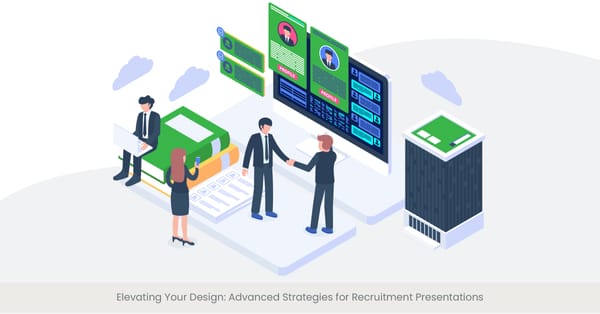
Setting the Stage: Welcome and Introduction
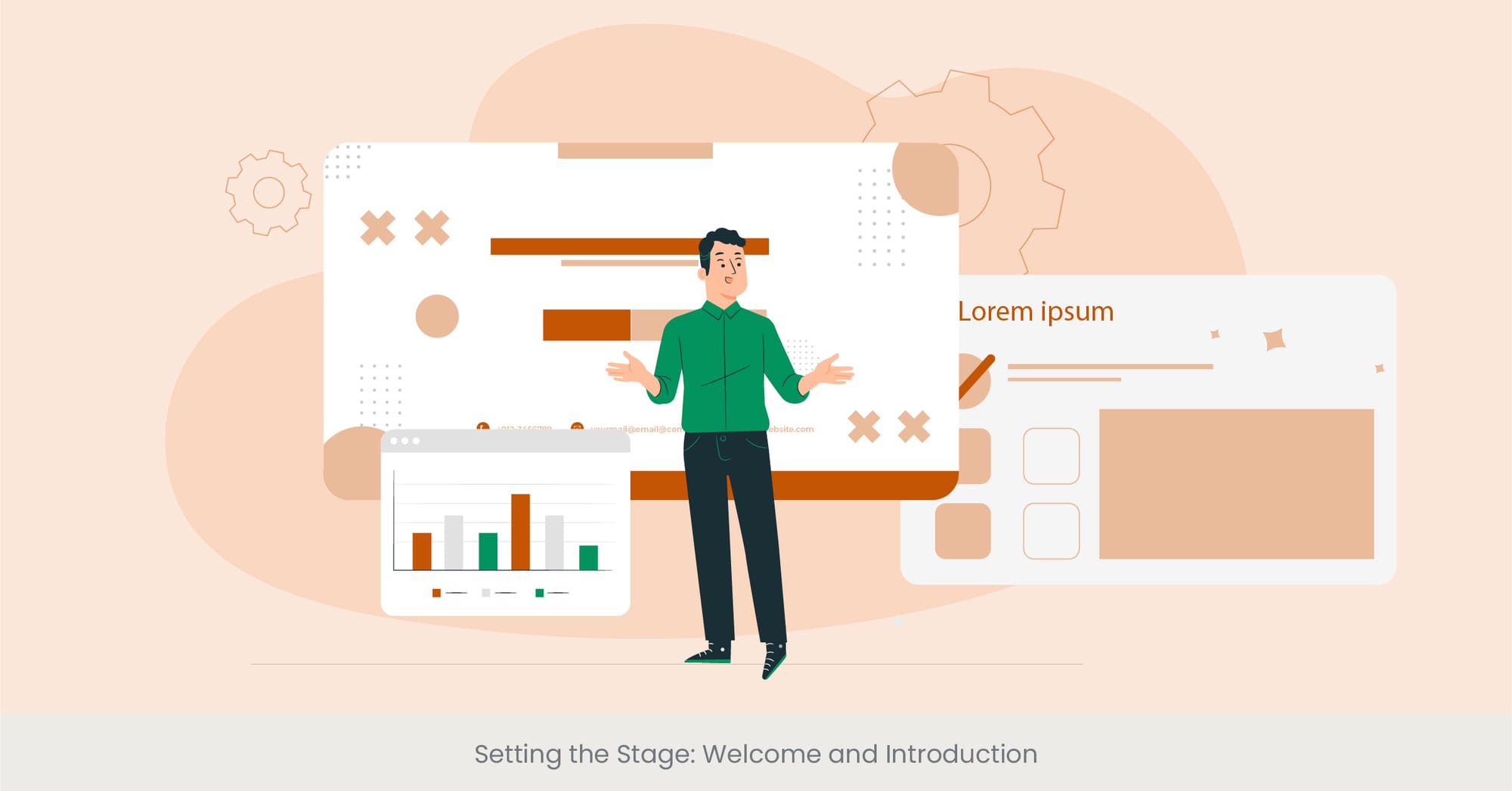
Creating an Engaging First Impression
The onboarding process is a crucial phase in the employee's journey, setting the tone for their experience with the organization. A well-crafted welcome and introduction serve as the first chapter of this journey, emphasizing the importance of making a positive and lasting impression. This phase is not just about conveying information; it's about making the new hires feel valued and excited about their decision to join the company. An effective introduction integrates the essence of the organization's culture, its people, and the expectations from the very start, ensuring a seamless transition into their roles.
The Foundation of Employee Engagement
Delving deeper into the welcome and introduction, it's clear that this stage is foundational to building a strong employer-employee relationship. This is where the new hires are first exposed to the company's ethos, its mission, and the values it stands for. By aligning the onboarding introduction with the organization's core principles, companies can foster a sense of belonging and purpose from day one. Historical anecdotes of the company's journey and achievements can serve as powerful tools in this narrative, providing a backdrop against which new employees can project their future contributions.
Real-World Applications: A Welcoming Blueprint
Across industries, companies that stand out in their onboarding processes often adopt innovative and welcoming strategies. From interactive sessions that replace the mundane reading of the handbook to engaging storytelling about the company's milestones, these approaches transform the introduction phase into an immersive experience. Companies like Zappos take it a step further by incorporating office tours that showcase company culture in action, thereby integrating new hires into the fabric of the organization seamlessly.
Establishing Credibility Through References
Research and case studies highlight the effectiveness of a dynamic welcome and introduction stage in the onboarding process. According to a report by the Society for Human Resource Management (SHRM), organizations with a strong onboarding process improve new hire retention by 82% and productivity by over 70%. These figures underscore the value of investing time and resources into crafting an introduction that resonates with new employees, laying the groundwork for their success and, by extension, the company's growth.
Company History, Mission, and Values
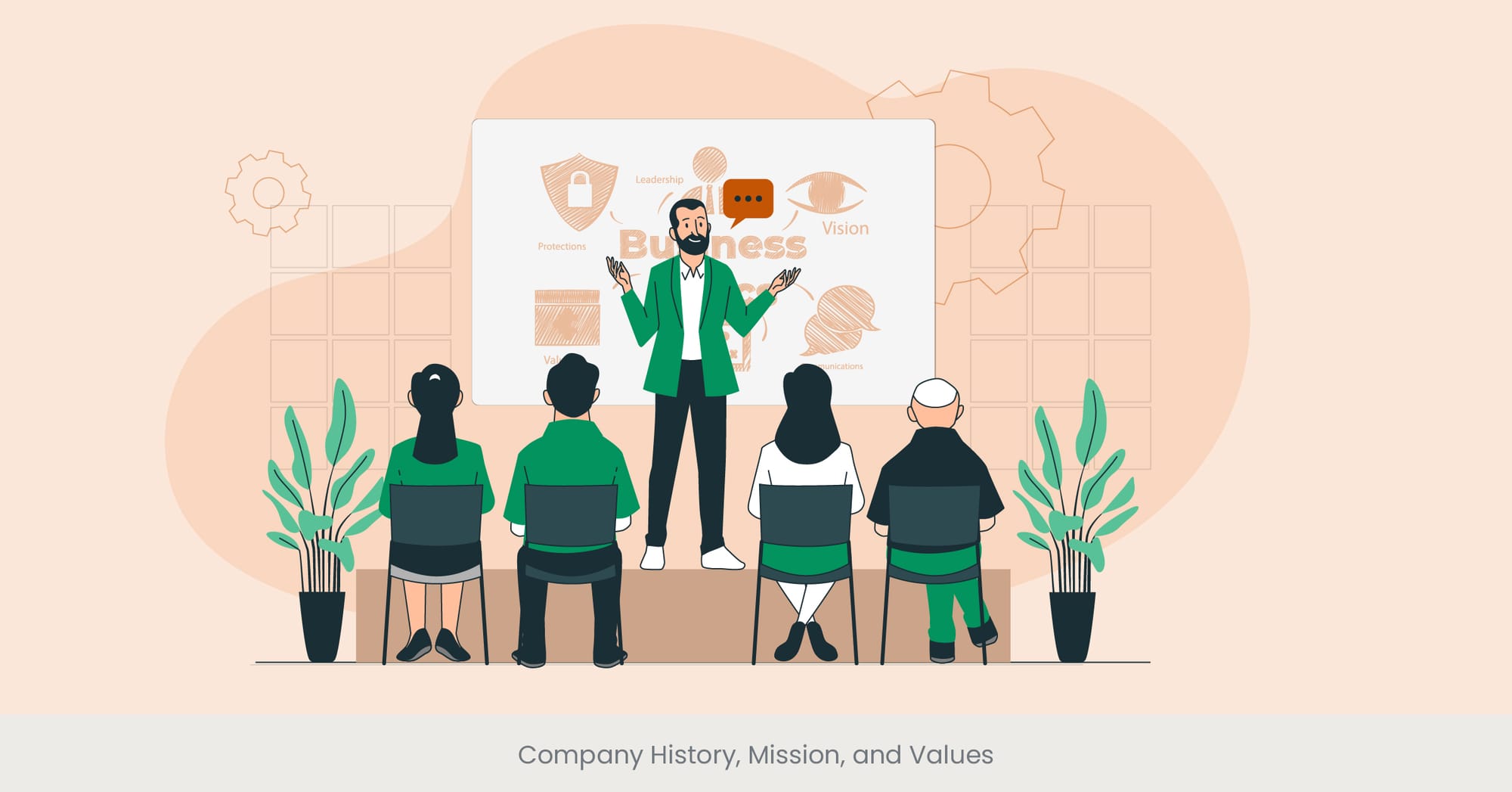
Embedding Tradition and Vision in Onboarding
Understanding a company's history, mission, and values is pivotal for new employees, as it connects them to the organization's purpose and legacy. This part of the onboarding presentation is not just informational but inspirational, aiming to instill a sense of pride and belonging from the outset. Through a detailed narrative of the company's journey—from its founding moments to its current achievements—new hires gain insights into the organization's identity and their role in its future.
The Backbone of Corporate Identity
The mission and values of a company act as the compass that guides its strategies, decisions, and culture. Presenting these elements in the onboarding process equips new hires with a clear understanding of what the company stands for and what it aims to achieve. This background knowledge is crucial for aligning personal goals with organizational objectives, fostering a cohesive work environment where everyone is moving in the same direction.
Illustrating Core Values Through Stories
Real-world examples and stories of how the company's values have shaped its decisions and successes bring abstract concepts to life. Whether it's a tale of innovation that led to a breakthrough product or a commitment to sustainability that influenced business practices, these stories exemplify the mission in action. They not only educate new employees about the company's values but also demonstrate how these principles are embedded in everyday operations and decision-making.
Validating with Data and Testimonials
Research shows that employees who feel a strong alignment with their company's mission and values are more engaged, satisfied, and productive. For instance, a Gallup study found that organizations that successfully engage their employees see a 21% increase in profitability. Incorporating statistics like these, along with testimonials from current employees about how the company's values influence their work, can powerfully underscore the importance of this alignment. It reassures new hires of the meaningful impact their contributions can have within the company and beyond.
Organizational Structure and Key Contacts

Navigating the Corporate Labyrinth
For new hires, understanding the organizational structure is akin to mapping the terrain of a new landscape. This segment of the onboarding presentation demystifies the hierarchy and the functional relationships between different departments and teams. It serves as a guide, helping new employees understand their position within the larger framework and how their contributions fit into the company's objectives. By introducing key contacts across the organization, the company facilitates smoother transitions, fostering a network of support and collaboration from day one.
The Pillars of Organizational Knowledge
Delving deeper, this part of the onboarding process underscores the importance of grasping the company's structure—not just who reports to whom but the rationale behind this design. This knowledge is fundamental, providing context for the company's communication flow, decision-making processes, and pathways for professional growth. It also highlights the role of key contacts as beacons for guidance, from direct manager to immediate supervisors to HR representatives, ensuring new hires know whom to approach with questions or for support.
Real-World Connect: Beyond the Org Chart
Illustrating this segment with real-world examples, such as how cross-departmental projects foster innovation or how mentorship programs within the structure aid career development, makes the organizational layout more relatable. Companies often share success stories of internal mobility or collaborative achievements to showcase the dynamic nature of their structure and the opportunities it presents. These anecdotes encourage new hires to see beyond their immediate roles and understand the potential pathways their career can take within the organization.
Backing It Up with Evidence
Studies have shown that clear understanding of organizational structure and access to key contacts significantly impact employee satisfaction and retention. For instance, a LinkedIn report highlights that employees who feel well-integrated into their workplace and have clear communication channels are more likely to remain with the company long-term. Including such statistics and perhaps feedback from employees who have successfully navigated the organizational structure to advance their careers reinforces the value of this knowledge.
Policies, Procedures, and Expectations
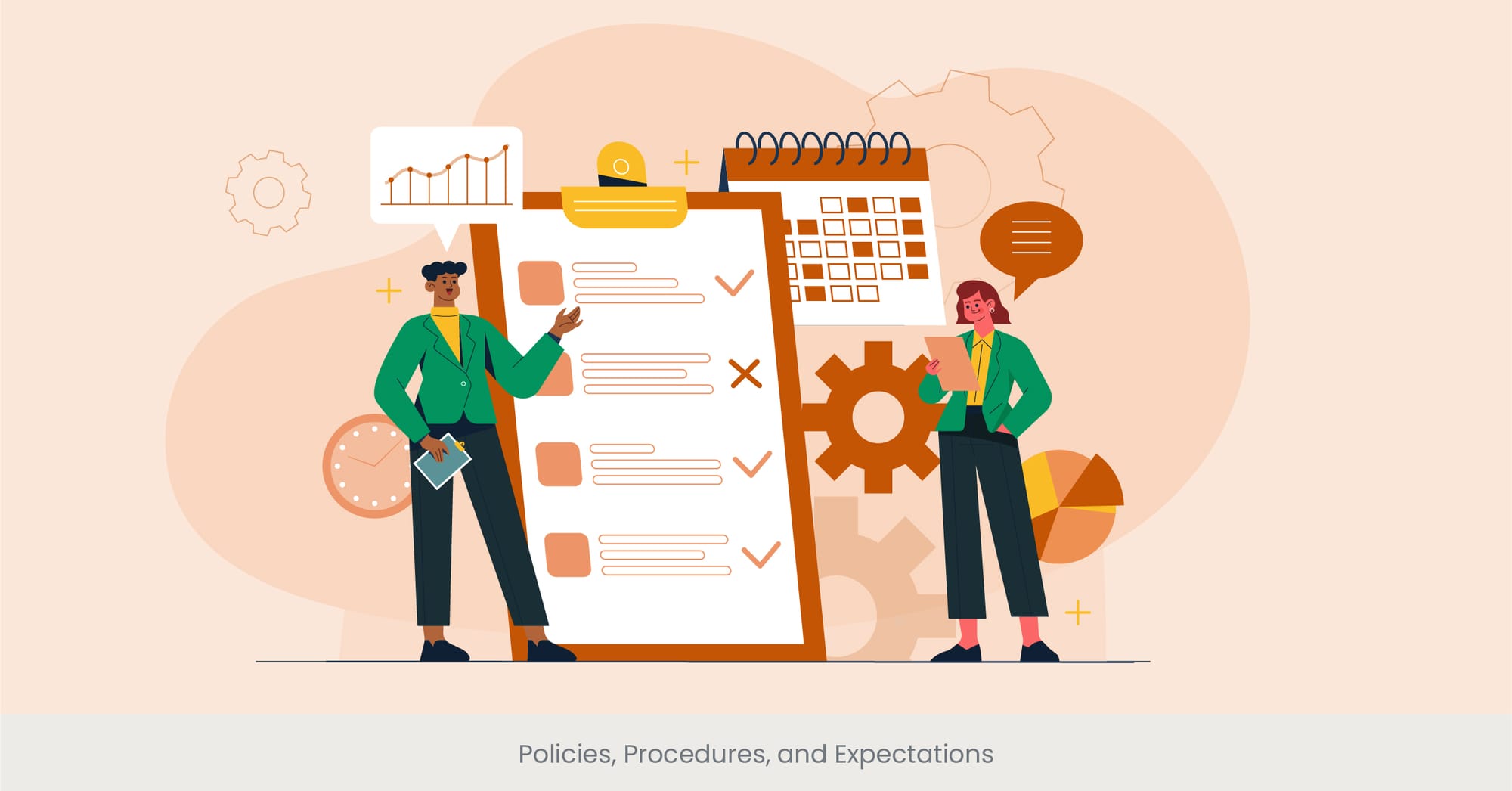
Laying the Groundwork for Professional Conduct
The introduction to a company's policies, procedures, and expectations is a cornerstone of the onboarding process, providing new hires with a clear framework of the operational dos and don'ts. This section is not merely informational; it's a proactive step towards fostering a transparent, respectful, and secure workplace environment. By outlining what is expected from employees in terms of conduct, performance, and compliance, companies set clear standards from the outset, minimizing misunderstandings and setting the stage for a positive work culture.
Understanding the Backbone of Company Operations
Diving into the specifics of policies and procedures offers new employees a deeper understanding of how the company operates on a day-to-day basis and the rationale behind certain rules. This segment might cover everything from daily operational procedures, security guidelines, to ethical standards, and use of company tools. Additionally, it introduces the new hires to the consequences of non-compliance, underscoring the importance of adherence for the smooth functioning of the company. This clarity not only helps in aligning personal behaviors with company standards but also in understanding the protective measures in place for employees and clients alike.
Bringing Policies to Life with Examples
Illustrating this section with real-life scenarios or case studies can significantly enhance understanding and retention. Whether it's a walkthrough of the hiring process, detailing how the company handles internal and external calls, or an explanation of the security guidelines through interactive elements, practical examples help in contextualizing the policies. These narratives can also include testimonials or scenarios where adherence to these policies played a crucial role in resolving issues or preventing conflicts, highlighting their relevance in the workplace.
Reinforced by Research and Feedback
Incorporating external references, such as industry best practices for policy implementation or studies showing the impact of clear procedures on employee productivity, adds a layer of credibility and urgency to this information. For instance, research by the HR Policy Association can be cited to showcase the correlation between well-communicated expectations and higher job satisfaction levels. Furthermore, testimonials from current employees about the benefits of a clear understanding of these guidelines reinforce their value, encouraging new hires to pay close attention.
Role-Specific Training and Goals
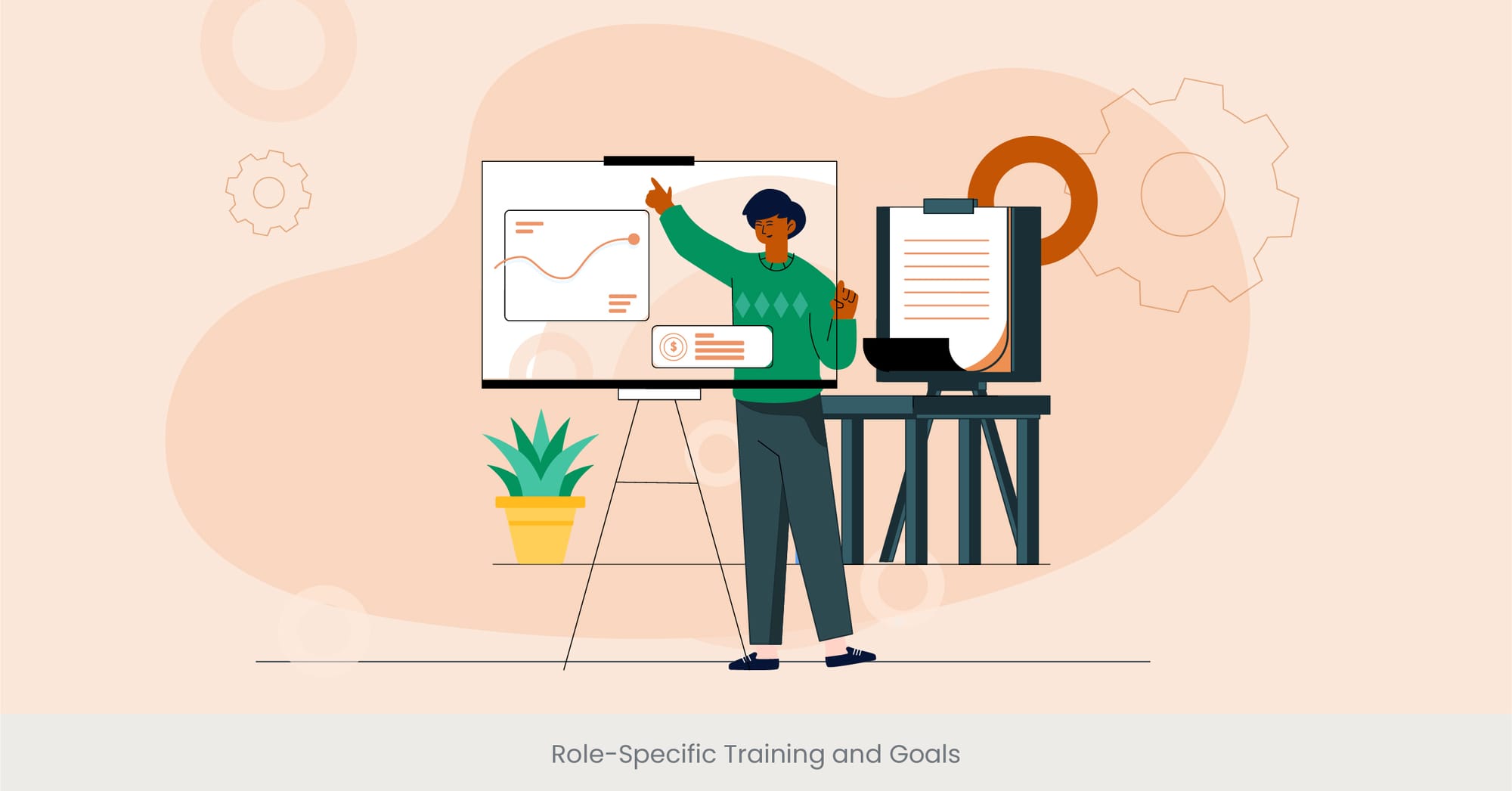
Crafting the Path for Individual Achievement
Role-specific training and goals are the linchpins of an effective onboarding process, tailored to bridge the gap between a new hire's existing skills and the competencies required in their new role. This segment of the onboarding presentation is critical, as it personalizes the experience, making it relevant and actionable for the individual. By outlining clear objectives and providing the necessary tools and knowledge through targeted training, companies empower new employees to contribute meaningfully and efficiently from the outset.
The Scaffold of Skill Development
Delving into the nuances of role-specific training involves more than just a list of tasks; it's about constructing a comprehensive development plan that addresses both the immediate functions of the role and its future trajectory within the company. This could include technical skills training, soft skills development, understanding company tools, and familiarity with product or service portfolios. Through this focused approach, new hires gain a deeper understanding of their role's impact on the company's goals, enhancing their engagement and motivation.
Real-World Application and Success Stories
Incorporating examples of how previous employees have successfully navigated their training to achieve their role-specific goals can be highly inspiring for new hires. Whether it's a case study of a sales team member who leveraged training to exceed targets or a developer who contributed to a pivotal project, these stories bring to life the potential for growth and achievement. Highlighting the resources available, such as mentorship programs or learning platforms, also showcases the company's investment in employee development.
Underpinned by Data and Industry Standards
Citing external sources that emphasize the importance of tailored training and goal-setting can further underscore their significance. For instance, studies by the Association for Talent Development (ATD) show that companies investing in comprehensive training programs experience a 218% higher income per employee. Additionally, leveraging industry benchmarks for role-specific achievements can set a clear standard for success, providing new hires with a concrete framework for their development path.
Integrating Company Culture into Onboarding

Fostering a Sense of Belonging from the Start
Integrating company culture into the onboarding process is crucial for nurturing a sense of belonging and alignment among new hires. This segment of the onboarding presentation is designed to immerse new employees in the ethos, behaviors, and practices that define the company, beyond the confines of their specific roles. By embedding cultural understanding early on, organizations lay the groundwork for a cohesive work environment where employees are motivated by shared values and visions.
The Essence of Organizational Identity
Deep diving into the company culture involves more than presenting a set of values; it's about showcasing how these values are lived out through daily operations, decision-making, and interpersonal interactions. This could include discussions on the company's approach to innovation, teamwork, diversity and inclusion, and social responsibility. It's also about illustrating the informal norms that govern day-to-day life within the company, such as communication styles, work-life balance, and recognition practices.
Culture in Action: Real-Life Examples
To effectively communicate the essence of company culture, sharing real-life examples and stories from within the organization is impactful. This might involve testimonials from employees about how the culture has supported their professional growth or anecdotes that demonstrate the company's values in action, such as community service initiatives or responses to global challenges. These narratives help new hires visualize how they can contribute to and benefit from the company culture.
Validating Culture with External Perspectives
Incorporating external references, such as awards for workplace culture, employee satisfaction surveys, or recognition from industry bodies, reinforces the authenticity and appeal of the company's cultural environment. Data highlighting the correlation between strong company culture and employee engagement, retention, and performance further underscores the importance of cultural integration in employee onboarding process. For example, a Gallup report might be cited to show that companies with highly engaged workforces outperform their peers by 147% in earnings per share.
Interactive Elements to Engage New Hires
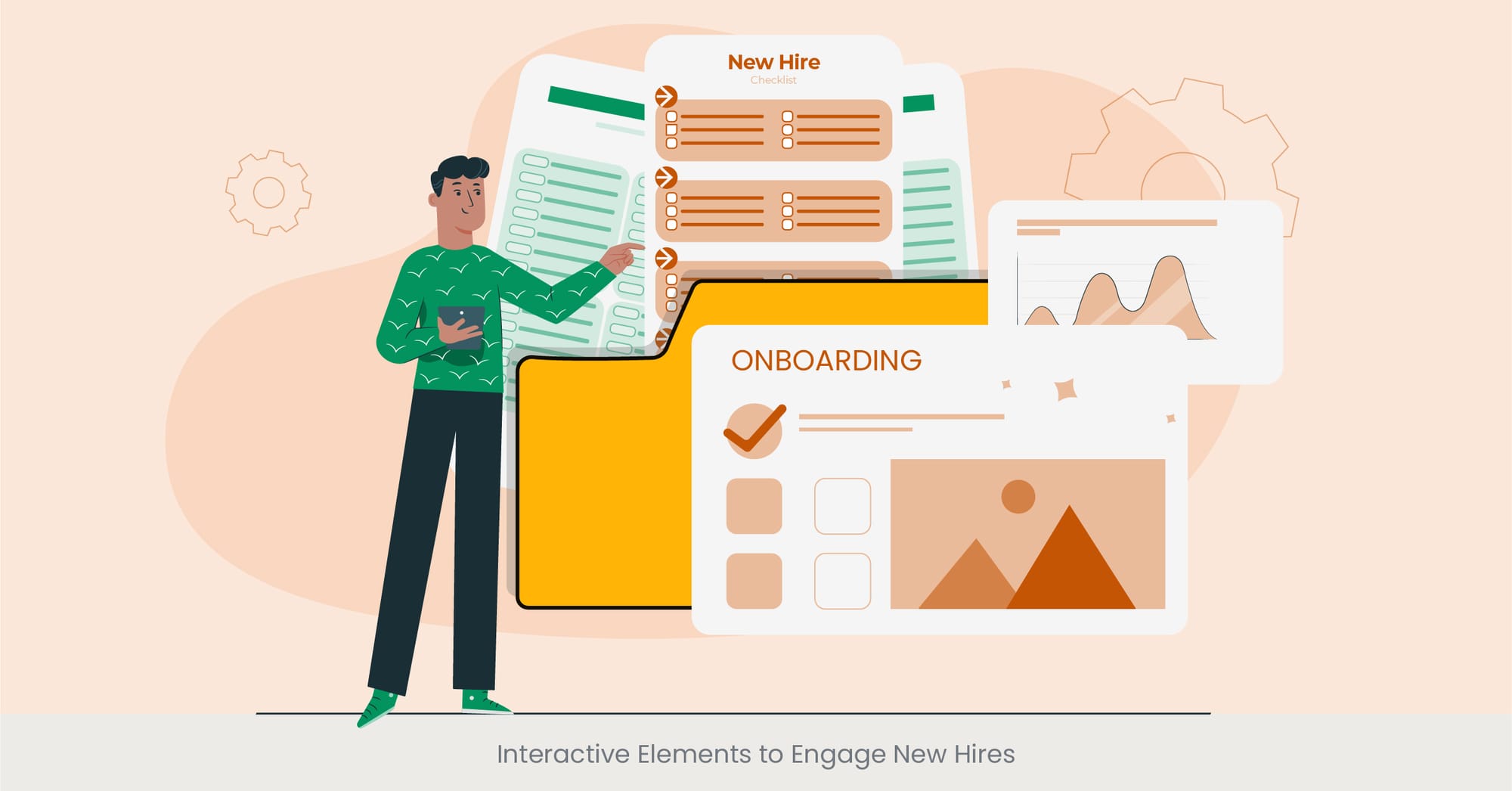
Enlivening the Onboarding Experience
Integrating interactive elements into the onboarding process marks a significant step towards engaging new hires in a meaningful and memorable way. This segment of the onboarding presentation focuses on transcending traditional, passive learning methods by incorporating activities that promote active participation and practical application. From simulations and gamification to role-playing and collaborative projects, interactive strategies enhance understanding and retention, making the onboarding process not just informative, but enjoyable and impactful.
The Mechanics of Engagement
Exploring the specifics of interactive elements, it becomes evident that these tools are designed to foster a deeper connection between new employees and the organizational culture, their roles, and their colleagues. Interactive onboarding can include virtual reality tours of the company, gamified learning modules that cover company policies and role-specific tasks, or team-building exercises that simulate real-life challenges. These methods support a hands-on learning approach, encouraging new hires to apply their knowledge in practice, thereby solidifying their understanding and boosting their confidence.
Applicant Onboarding Slides
When designing applicant onboarding slides, focus on creating engaging visuals and interactive content that enhances the new hire's understanding. These slides should include essential information about company policies, role expectations, and team introductions. By integrating multimedia elements, you can ensure a memorable and informative onboarding experience.
Success Stories: Interaction in Action
Presenting real-world examples of successful interactive onboarding programs can serve as a powerful testament to their effectiveness. Companies that have implemented gamified learning experiences often report higher engagement rates and quicker assimilation into company culture. For instance, a tech firm might share how its virtual onboarding scavenger hunt led to a notable increase in new hire satisfaction and early productivity. Similarly, stories of interactive role-playing sessions that prepare new employees for client interactions can illustrate the practical benefits of these methods.
Evidence-Based Endorsement
Incorporating research findings and expert opinions on the benefits of interactive onboarding elements further validates their value. Studies suggest that interactive training methods can significantly improve knowledge retention and application, with some research indicating that employees in interactive onboarding programs are 45% more likely to feel adequately prepared for their roles. Referencing industry benchmarks or awards for innovative onboarding solutions can also highlight the strategic advantage of adopting interactive elements.
Job Fair Presentation Slides
Job fair presentation slides serve as an excellent tool for engaging potential hires during recruitment events. These slides should emphasize the company’s culture, job openings, and growth opportunities. Utilizing vibrant graphics and key messaging helps attract the right talent and leaves a lasting impression on attendees.
Feedback Mechanisms: Ensuring Continuous Improvement
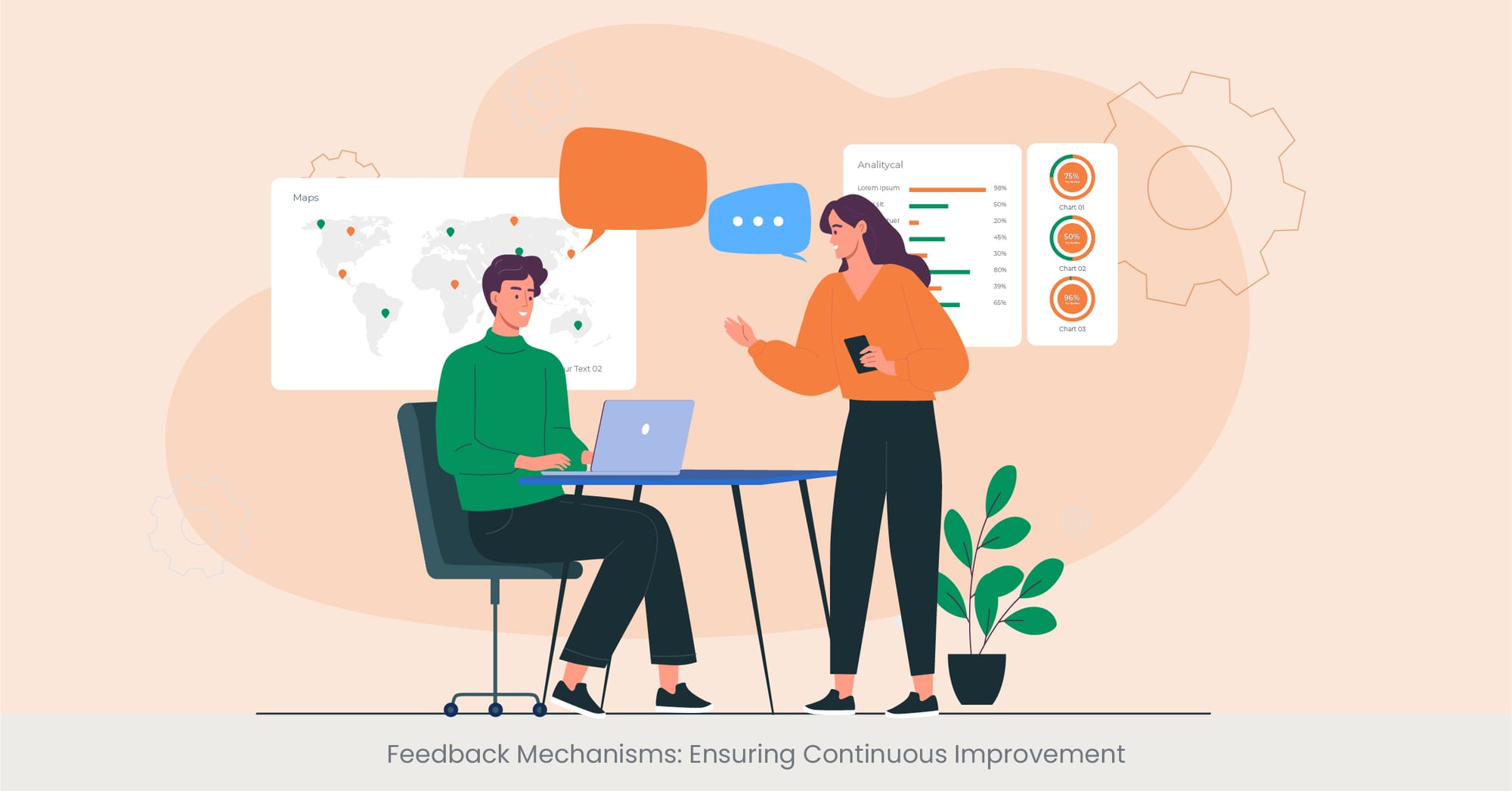
Building a Culture of Open Communication
Incorporating feedback mechanisms into the onboarding process is crucial for fostering an environment of continuous improvement and open communication. This segment of the presentation underscores the importance of creating channels through which new hires can share their experiences, insights, and suggestions regarding the onboarding process. By actively soliciting and valuing feedback, companies demonstrate a commitment to optimizing the onboarding experience, showing that they are responsive to the needs and perspectives of their employees.
Digital Recruitment Presentations
Digital recruitment presentations play a crucial role in modern hiring strategies. These presentations can be shared virtually, making them a great way to present your onboarding process to remote candidates. By using dynamic visuals and easy-to-understand content, digital recruitment presentations ensure clarity and accessibility for candidates regardless of their location.
The Framework for Feedback
Delving into the mechanisms for feedback, it becomes clear that a structured approach is essential. This can include scheduled one-on-one meetings with the HR team or direct managers, anonymous surveys, or digital platforms designed for real-time feedback. The goal is to make the process of giving feedback as accessible and non-intimidating as possible, encouraging honest and constructive communication. Through this framework, companies can gather actionable insights, identifying areas of the onboarding process that are effective as well as those that may require adjustments.
Real-Life Implementations and Outcomes
Highlighting examples of how feedback has led to tangible improvements in the onboarding process can inspire confidence in the system. Whether it's a case where new employee orientation checklist and suggestions led to the introduction of new onboarding templates, the modification of training programs, or the enhancement of interactive elements, these stories validate the impact of feedback. Sharing specific outcomes, such as increased satisfaction rates or reduced time-to-productivity, further illustrates the value of listening and responding to new hire input.
Supporting Evidence and Expert Perspectives
Citing external sources that emphasize the importance of feedback in the onboarding process lends credibility to its inclusion. Research indicating that companies that excel in onboarding are more likely to have regular feedback mechanisms in place can be particularly persuasive. Expert opinions or best practice guidelines from organizations like the Society for Human Resource Management (SHRM) can provide additional support, suggesting that effective feedback mechanisms are a hallmark of successful onboarding programs.
Follow-Up: The Next Steps After Initial Onboarding

Ensuring Continued Engagement and Success
The follow-up stage after initial onboarding is critical for maintaining momentum and ensuring the successful integration of new hires into the company. This segment of the onboarding presentation emphasizes the importance of structured follow-up actions that extend beyond the first week or month, providing ongoing support and guidance. By mapping out the next steps after the initial onboarding phase, companies can reinforce their commitment to the employee's growth and development, ensuring a smoother transition into their new role and the organizational culture.
Strategic Follow-Up Initiatives
The essence of effective follow-up lies in its ability to adapt to the individual needs of the new hire while maintaining a structured approach. This can include regular check-ins with managers or mentors, advanced training sessions tailored to the evolving demands of the role, and opportunities for early involvement in projects to apply newly acquired skills. Additionally, setting clear milestones and goals for the first 90 days can give new employees a sense of direction and purpose, enhancing their engagement and productivity.
Workforce Development Presentations
Workforce development presentations are key in ensuring ongoing employee growth. These presentations should outline training opportunities, career development paths, and leadership programs. By integrating these presentations into follow-up initiatives, you reinforce the commitment to employee growth, ensuring they feel supported throughout their journey within the company.
Illustrating Success Through Case Studies
Sharing success stories of employees who have thrived as a result of thoughtful follow-up can serve as powerful motivation for new hires. These anecdotes can highlight how continuous support helped individuals overcome early challenges, achieve their initial set of goals, and even exceed expectations. Whether it's a story about a new hire who led a significant project within their first six months or someone who rapidly advanced thanks to targeted development plans, these examples bring to life the potential impact of effective follow-up.
Backed by Research and Best Practices
Incorporating data and insights from external sources can further emphasize the importance of the follow-up stage. Studies showing that ongoing support and development opportunities can significantly improve retention rates and job satisfaction offer a compelling case for robust follow-up strategies. References to industry best practices, such as the recommendation from the Harvard Business Review on the optimal frequency and format of check-ins, provide a framework for designing effective follow-up programs.
Evaluating Onboarding Effectiveness: Metrics and Adjustments
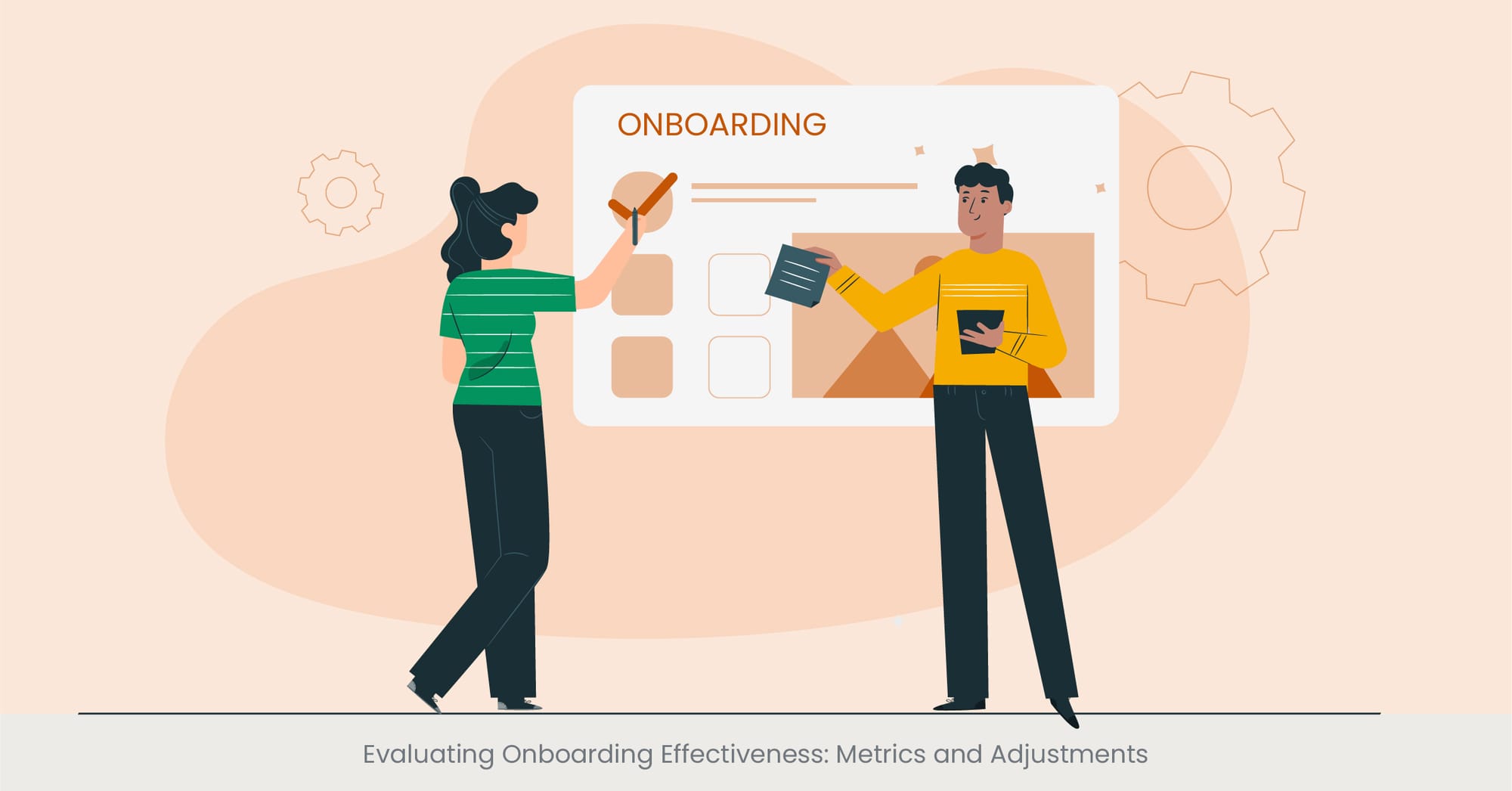
Measuring Success for Continuous Improvement
The evaluation of onboarding effectiveness is an essential component of a robust onboarding program, enabling organizations to assess the impact of their strategies and make necessary adjustments. This segment of the onboarding presentation focuses on the importance of establishing clear metrics and feedback loops to gauge the success of the onboarding process. By systematically analyzing these metrics, companies can identify strengths and areas for improvement, ensuring the onboarding experience remains dynamic and responsive to the needs of new hires.
Key Metrics for Onboarding Success
Identifying the right metrics is crucial for a meaningful evaluation. These can include quantitative measures such as retention rates, time-to-productivity, and completion rates of onboarding activities, as well as qualitative feedback from new hires regarding their satisfaction and engagement levels. Additionally, measuring the alignment between an employee's expectations and their actual experience can provide insights into the effectiveness of the onboarding process. These metrics, collectively, offer a comprehensive view of how well the onboarding program is achieving its goals.
Real-World Insights: Learning from Adjustments
Showcasing examples of how organizations have used these metrics to refine their onboarding processes can illustrate the value of continuous evaluation. For instance, a case study might reveal how a company redesigned its onboarding process after identifying a gap in role-specific training, leading to improved performance and satisfaction among new hires. Another example could highlight how feedback on the onboarding introduction led to the incorporation of more interactive elements, enhancing engagement and retention.
Leveraging External Benchmarks and Research
Incorporating findings from external research and industry benchmarks can lend additional credibility to the evaluation process. Studies demonstrating the correlation between effective employee onboarding, and key organizational outcomes, such as increased employee loyalty and higher profitability, underscore the importance of ongoing assessment and refinement. References to best practices in onboarding evaluation, such as those from leading HR organizations, can guide companies in establishing a robust framework for measuring and enhancing their onboarding effectiveness.
FAQs on Onboarding Presentation

What are the 5 C's of onboarding?
The 5 C's of onboarding are Compliance, Clarification, Culture, Connection, and Check-back. Compliance introduces new hires to legal and policy-related requirements. Clarification ensures employees understand their roles and expectations. Culture helps new hires assimilate the company's values and norms. Connection fosters relationships with colleagues. Check-back involves regular follow-ups for feedback and support.
How do I create an onboarding checklist?
Creating an onboarding checklist involves outlining all the necessary steps and information new hires need from their first day to their first few months. Start by including basic administrative tasks, then integrate role-specific training, introductions to team members, culture immersion activities, and regular check-ins for feedback. Utilize free onboarding checklist templates and feedback from previous onboarding experiences to refine the checklist.
What are the 4 C's of effective onboarding?
The 4 C's of effective onboarding are Compliance, Clarification, Culture, and Connection. These components ensure new hires are aware of policies (Compliance), understand their job duties and expectations (Clarification), feel integrated into the company culture (Culture), and establish meaningful connections with their colleagues (Connection).
What are the six critical steps of onboarding?
The six critical steps of smooth onboarding process include Pre-onboarding communications, Formal welcome and introductions, Training and development plans, Culture immersion, Role clarification and goal setting, and Ongoing support and feedback. These steps guide new hires through understanding their role, the company culture, and the resources available to them, ensuring a smooth transition into their new position.
What are the 7 stages of onboarding?
The 7 stages of onboarding are Pre-employment engagement, First day employee orientation checklist and, Initial training and development, Role-specific training, Culture integration, Performance management, and Ongoing development and retention. These stages encompass the entire journey of a new hire, from the moment they accept the job offer to becoming a fully integrated, productive member of the team.
What is an onboarding checklist?
An onboarding checklist is a comprehensive list of tasks and activities designed to ensure new employees have all the necessary information, tools, and resources to successfully integrate into their new role and the company. It typically covers administrative setup, training sessions, culture immersion activities, and meetings with key team members.
What is the 4 step onboarding process?
The 4 step onboarding process includes Orientation (introducing the new hire to the company and its policies), Role-specific training (equipping the new employee orientation with the skills and knowledge needed for their job), Integration (helping the employee assimilate into the company culture and build relationships), and Performance evaluation (providing feedback and setting goals).
What are the 5 stages of the onboarding process?
The 5 stages of the onboarding employee orientation process are Preparation (before the new hire's first day), Welcome and administrative setup, Training and development, Culture assimilation, and Ongoing support and evaluation. These stages ensure a smooth transition for the new hire into their role and the company.
How do you introduce onboarding?
Introducing onboarding involves explaining the process and its objectives to the new hire, ensuring they understand it's a comprehensive program designed to help them acclimate to their new role and the company. It should start with pre-onboarding communications and include a detailed overview of what to expect in the coming days and weeks.
How do you explain onboarding?
Onboarding is the process through which new employees gain the necessary knowledge, skills, and behaviors to become effective organizational, new team members, and insiders. It encompasses various activities, including orientation, training, meetings with key team members, and integration into the company culture, aimed at ensuring a smooth transition for the new employee.



%20(1).jpg)
%20(1).jpg)


